Crosley C31100PAV, C31000PAT, C31000PAA, C31000PAW, 31100PAA Installation Instructions
...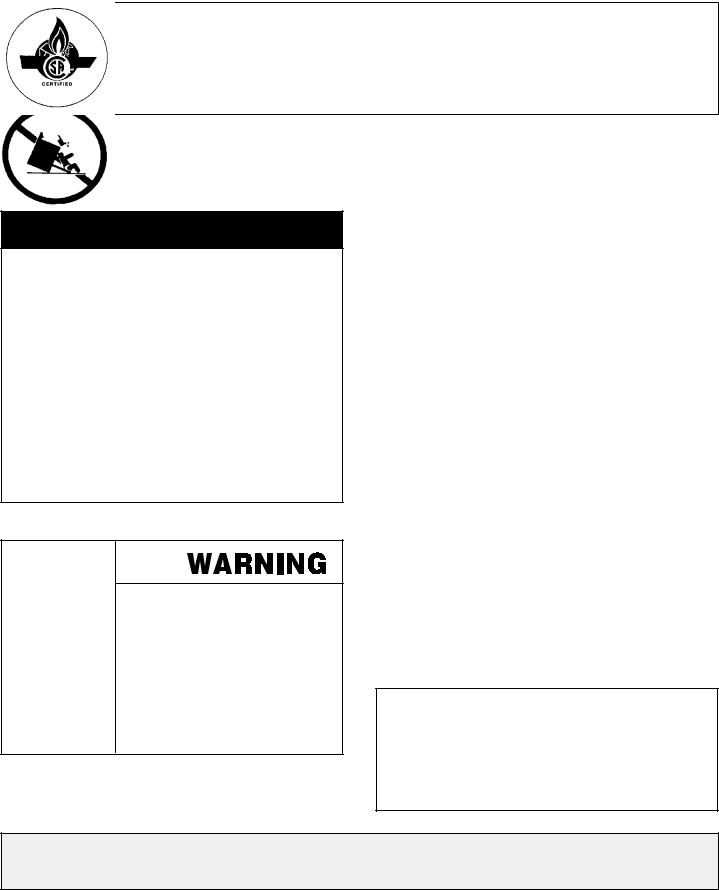
INSTALLER: LEAVE THESE INSTRUCTIONS WITH THE APPLIANCE
INSTALLATION MANUAL
Gas 30-inch Wide Free-standing Range
PLEASE KEEP THIS MANUAL FOR FUTURE REFERENCE
THE MANUAL IS INTENDED TO ASSIST IN THE INITIAL INSTALLATION AND ADJUSTMENTS OF THE RANGE.
SPECIAL WARNING
Only qualified personnel should install or service this range.
Read “Safety Instructions” in the Use & Care book before using range.
Improper installation, adjustment, alteration, service, maintenance or use of range can result in serious injury or property damage.
ALL RANGES CAN TIP AND CAUSE INJURIES TO PERSONS.
INSTALL ANTI-TIP DEVICES PACKED WITH RANGE.
FOLLOW ALL INSTALLATION INSTRUCTIONS.
CLEARANCE DIMENSIONS
Range may be installed with zero inches clearance adjacent to (against) combustible construction at the rear and on the sides below the cooktop. For complete information in regard to the installation of wall cabinets above the range and clearances to combustible wall above the cooking top see the installation drawings. For SAFETY CONSIDERATIONS do not install a range in any combustible cabinetry which is not in accord with the installation drawings.
* NOTE: 30 inch (76.2 cm) dimension between cooking top and wall cabinet shown on illustration does not apply to ranges with an elevated oven. The 30 inch (76.2 cm) dimension may be reduced to not less than 24 inches (61 cm) when the wall cabinets in a domestic home are protected with fireproof materials in accordance with American National Standards - National Fuel Gas Code or in mobile homes when they are protected with fireproof materials in accordance with the Federal Standard for Mobile Home Construction and Safety.
To eliminate the risk of burns or fire by reaching over heated surface units, cabinet storage space located above the surface units should be avoided. If cabinet storage is to be provided, the risk can be reduced by installing a range hood that projects horizontally a minimum of 5 inches (13 cm) beyond the bottom of the cabinets.
CAUTION: This range has been designed in accordance with the requirements of various safety agencies and complies with the maximum allowable wood cabinet temperatures of 194 F. If this range is installed with cabinets that have a lower working temperature than 194 F, discoloration, delamination or melting may occur.
Your range may not be equipped with some of the features referred to in this manual.
8101P636-60
(02-04-00)
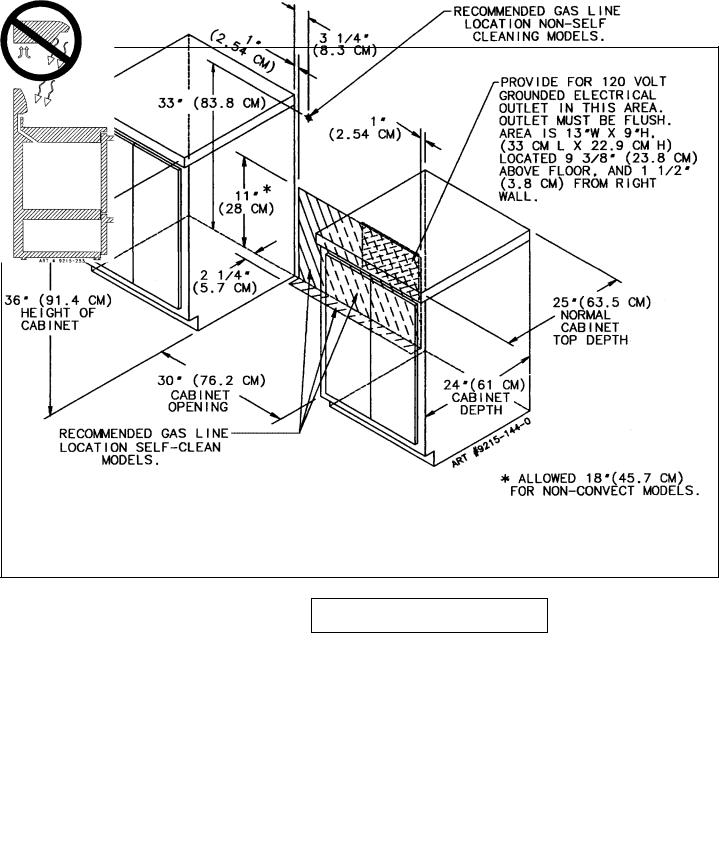
INSTALLATION DRAWINGS
FREE-STANDING
 WARNING
WARNING
THIS PRODUCT SHOULD NOT BE INSTALLED BELOW A VENTILATION TYPE HOOD SYSTEM THAT DIRECTS AIR IN A DOWNWARD DIRECTION.
(SEE FIGURE)
THESE SYSTEMS MAY CAUSE IGNITION AND COMBUSTION PROBLEMS WITH THE GAS BURNERS RESULTING IN PERSONAL INJURY AND MAY AFFECT THE COOKING PERFORMANCE OF THE UNIT.
NOTE: THE FIGURE MAY NOT ACCURATELY
REPRESENT YOUR RANGE OR COOKTOP;
HOWEVER, THIS WARNING APPLIES TO ALL
GAS COOKING PRODUCTS.
-2-
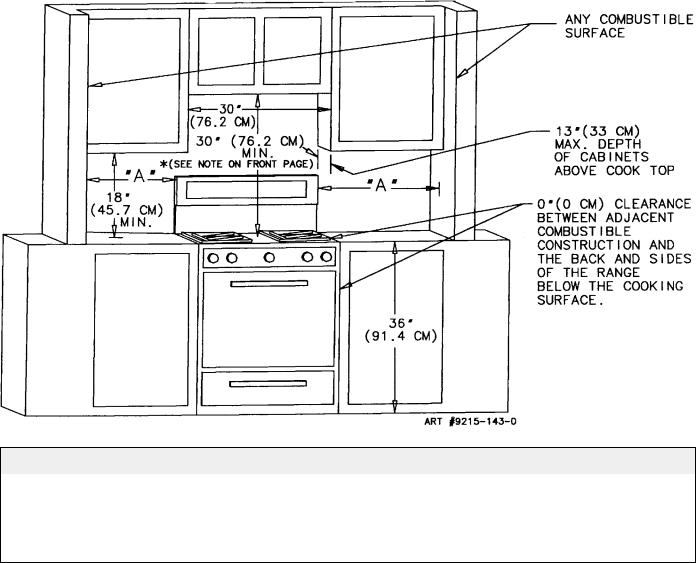
DIMENSION “A” SIDE CLEARANCE ABOVE COOKING SURFACE
TOP BURNER RATE FOR |
|
|
|
NATURAL GAS (SEE RATING PLATE) |
CONVENTIONAL OVEN |
SELF-CLEAN OVEN |
|
|
|
|
|
9,200 BTU/HR OR LESS |
0 |
INCHES |
3 INCHES (7.6 CM) |
|
|
|
|
MORE THAN 9,200 BTU/HR |
1 |
INCH (2.5 CM) |
3 INCHES (7.6 CM) |
|
|
|
|
Check the range model number plate to see if the range is approved for installation in mobile homes and/or recreational park trailers. If approved the following items are applicable.
MOBILE HOMES
The installation of a range designed for mobile home installation must conform with the Manufactured Home Construction and Safety Standard, Title 24 CFR, Part 3280 [formerly the Federal Standard for Mobile Home Construction and Safety, Title 24 HUD, (Part 280)] or, when such standard is not applicable, the Standard for Manufactured Home Installations, ANSI A225.1/NFPA 501A, or with local codes.
In Canada the range must be installed in accordance with the current CSA Standard C22.1 - Canadian Electrical Code Part 1 and Section Z240.4.1 - Installation Requirements for Gas Burning Appliances in Mobile Homes (CSA Standard CAN/CSA - Z240MH).
RECREATIONAL PARK TRAILERS
The installation of a range designed for recreational park trailers must conform with state or other codes or, in the absence of such codes, with the Standard for Recreational Park Trailers, ANSI A119.5-latest edition.
In Canada the range must be installed in accordance with CAN/CSA - Z240.6.2 - Electrical Requirements for R.V.’s (CSA Standard CAN/CSA - Z240 RV Series) and Section Z240.4.2 - Installation Requirements for Propane Appliances and Equipment in R.V.’s (CSA Standard CAN/CSA - Z240 RV Series).
LOCATING THE RANGE
Do not set range over holes in the floor or other locations where it may be subject to strong drafts. Any opening in the wall behind the range and in the floor under the range should be sealed. Make sure the flow of cooling/ ventilation air is not obstructed below the range.
NOTE: A range should NOT be installed over kitchen carpeting.
-3-

ANTI-TIP DEVICE INSTALLATION INSTRUCTIONS
NOTE: A risk of range tip over exists if the appliance is not installed in accordance with the installation instructions provided. The proper use of this device minimizes the risk of TIP-OVER. In using this device the consumer must still observe the safety precautions as stated in the USE and CARE MANUAL and avoid using the oven door and/or lower drawer as a step stool.
Installation instructions are provided for wood and cement in either floor or wall. Any other type of construction may require special installation techniques as deemed necessary to provide adequate fastening of the ANTI-TIP bracket to the floor or wall.
STEP 1 - Locating The Bracket (see figure 1)
A.Determine where either the right or left rear “edge” of the range will be located and mark the floor or wall.
B.Place the BRACKET 15/16 (24 mm) from the marked “EDGE” toward center of opening and against the back wall as shown in figure 1, with orientation hole against wall.
C.Use the bracket as a template and mark the required holes, as shown in figure 1 for the type of construction you will be using.
STEP 2 - Anti-Tip Bracket Installation
A.Wood Construction:
1.Floor: Locate the center of the two holes identified in figure 1 as “HOLES FOR FLOOR”. Drill a 1/8 (3 mm) pilot hole in the center of each hole (a nail or awl may be used if a drill is not available). Secure the ANTI-TIP bracket to the floor with the two screws provided. Proceed to STEP 3.
2.Wall: Locate the center of the two holes identified in figure 1 as “HOLES FOR WALL. Drill an angled 1/8 (3 mm) pilot hole in the center of each hole
as shown in figure 2. (A nail or awl may be used if a drill is not available). Secure the ANTI-TIP bracket to the wall with the two screws provided as shown in figure 2. Proceed to STEP 3.
B.Cement or Concrete Construction:
1.Suitable screws for concrete construction can be obtained at a hardware store. Drill the required size hole for the screws obtained into the concrete at the center of the holes identified in figure 1 as “HOLES FOR FLOOR”. Secure the ANTI-TIP bracket to the floor. Proceed to STEP 3.
STEP 3 - Range Installation
A.A free-standing range may be installed by one person.
B.Align the range to its designated location and slide it back into position. Note: A minimum clearance of 1/4 (6 mm) is required between the range and the leveling foot that will engage the ANTI-TIP bracket, see figure 2.
CAUTION: Damage to the range may occur if range is moved or lifted by grasping the main top or backguard.
C.For SAFETY CONSIDERATIONS as well as optimum performance adjust the range so that it is level. This may be checked by placing a spirit level or a large pan of water on the cooktop or the oven rack. If an adjustment is required pull the range forward, tip the range and rotate the leveling feet as required.
D.To check the range for proper installation of the anti-tip bracket: Use a flashlight and look underneath the bottom of the range to see that one of the rear leveling feet is engaged in the bracket slot.
E.Proceed with the remainder of the installation instructions provided with the range.
FIGURE 1 |
|
FIGURE 2 |
|
|
|
-4-
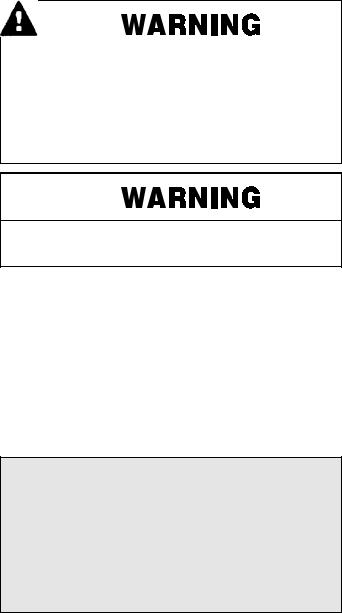
CONNECTING THE RANGE
ELECTRIC SUPPLY
The appliance, when installed, must be electrically grounded in accordance with local codes or, in the absence of local codes, with the National Electrical Code, ANSI/NFPA 70.
In Canada the range must be installed in accordance with the current CSA Standard C22.1 - Canadian Electrical Code Part 1.
ELECTRICAL SUPPLY CONNECTION:
The range requires 120 volts, 60 cycle alternating current from an outlet. See serial plate for rating.
User may experience occasional circuit tripping if Ground Fault Circuit Interrupter (GFCI) outlet or breaker is in use.
Electrical Grounding Instructions
This appliance is equipped with a (three-prong) grounding plug for your protection against shock hazard and should be plugged directly into a properly grounded receptacle. Do not cut or remove the grounding prong from this plug.
DISCONNECT ELECTRICAL SUPPLY
BEFORE SERVICING THE APPLIANCE.
GAS SUPPLY
Installation of this range must conform with local codes or, in the absence of local codes, with the National Fuel Gas Code, ANSI Z223.1-latest edition.
In Canada the range must be installed in accordance with the current CGA Standard CAN/CGA-B149 - Installation Codes for Gas Burning Appliances and Equipment and/or local codes.
In The Commonwealth Of Massachusetts
This product must be installed by a licensed plumber or gas fitter when installed within the Commonwealth of Massachusetts.
A “T” handle type manual gas valve must be installed in the gas supply line to this appliance.
A flexible gas connector, when used, must not exceed a length of three (3) feet / 36 inches.
GAS SUPPLY CONNECTION: (See figure 4)
A QUALIFIED SERVICEMAN OR GAS APPLIANCE INSTALLER MUST MAKE THE GAS SUPPLY CONNECTION. Leak testing of the appliance shall be conducted by the installer according to the instructions given in section h.
NATURAL GAS SUPPLY LINE MUST HAVE A NATURAL GAS SERVICE REGULATOR. INLET PRESSURE TO THIS APPLIANCE SHOULD BE REDUCED TO A MAXIMUM OF 14 INCHES WATER COLUMN (0.5 POUNDS PER SQUARE INCH (P.S.I.) LIQUEFIED PETROLEUM (L.P.)/PROPANE GAS SUPPLY LINE MUST HAVE A L.P. GAS PRESSURE REGULATOR. INLET PRESSURE TO THIS APPLIANCE SHOULD BE REDUCED TO A MAXIMUM OF 14 INCHES WATER COLUMN (0.5 P.S.I.). INLET PRESSURES IN EXCESS OF 0.5 P.S.I. CAN DAMAGE THE APPLIANCE PRESSURE REGULATOR AND OTHER GAS COMPONENTS IN THIS APPLIANCE AND CAN RESULT IN A GAS LEAK.
a.A GAS CUTOFF VALVE SHOULD BE PUT IN AN ACCESSIBLE LOCATION IN THE SUPPLY LINE AHEAD OF THE RANGE, FOR TURNING ON AND TURNING OFF GAS SUPPLY. If range is to be connected to house piping with flexible or semi-rigid metal connectors for gas appliances, CONNECTOR NUTS MUST NOT BE CONNECTED DIRECTLY TO PIPE THREADS. THE CONNECTORS MUST BE INSTALLED WITH ADAPTORS PROVIDED WITH THE CONNECTOR.
b.The house piping and/or range connector used to connect the range to the main gas supply must be clean, free of metal shavings, rust, dirt and liquids (oil or water). Dirt, etc. in the supply lines can work its way into the range manifold and in turn cause failure of the gas valves or controls and clog burners and/or pilot orifices.
CAUTION: DO NOT LIFT OR MOVE RANGE BY DOOR HANDLES, OR BACKGUARD.
c.Turn off all pilots and main gas valve of other gas appliances.
d.Turn off main gas valve at meter.
e.Before connecting range, apply pipe thread compound approved for LPG to all threads.
f.Connect range to gas supply at appliance pressure regulator using adaptors supplied with flexible connector. Rigid pipe may also be used. See rating plate for type of gas range has been manufactured for.
g.Turn on main gas valve at meter, and relight pilots at other gas appliances.
-5-
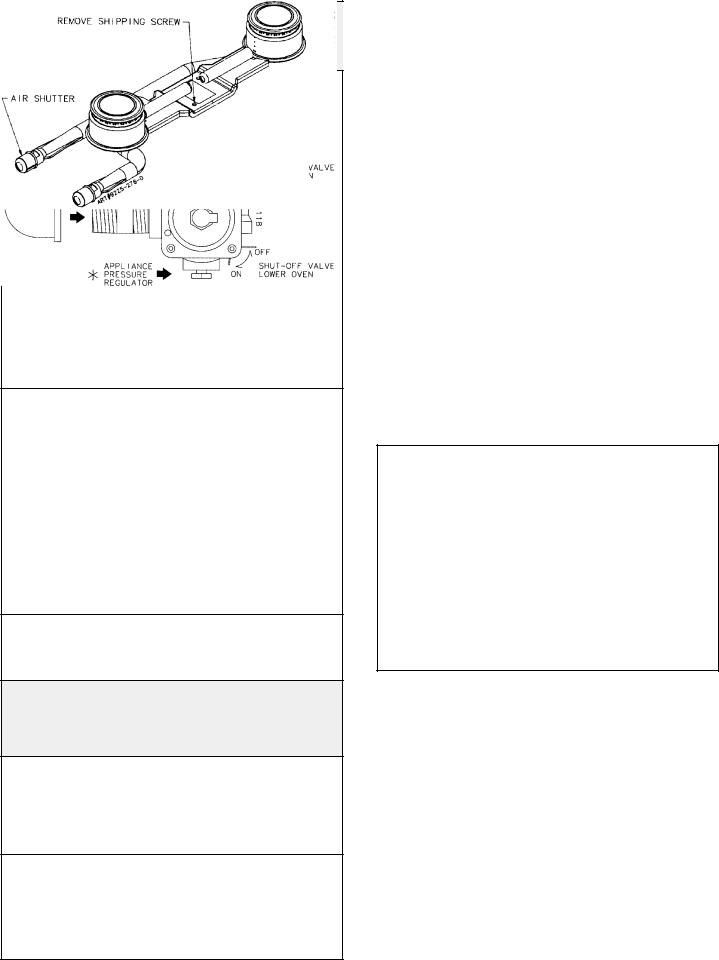
Gas Supply Connections For Ranges With
Appliance Pressure Regulator
Located In The Bottom Of Range
TO CONNECT GAS SUPPLY TO 1/2I N.P.T. MALE INLET
TO CONNECT GAS SUPPLY TO 1/2I N.P.T. FEMALE INLET
WHEN THE INSTALLER HAS COMPLETED INSTALLATION OF THE APPLIANCE, LEAVE THE APPLIANCE PRESSURE REGULATOR SHUT-OFF VALVE IN THE “ON” POSITION.
Gas Supply Connection For Ranges With
Appliance Pressure Regulator
Located Under Main Top Of Range
FIGURE 4
Appliance Pressure Regulator
&Alternate Connectors
* The appliance pressure regulator on your range may differ from this illustration.
h.Apply a non-corrosive leak detection fluid to all joints and fittings in the gas connection between the supply line shut-off valve and the range. Include gas fittings and joints in the range if connections were disturbed during installation. Check for leaks! Bubbles appearing around fittings and connections will indicate a leak. If a leak appears, turn off supply line gas shut-off valve, tighten connections, turn on the supply line gas shut off valve, and retest for leaks.
CAUTION: NEVER CHECK FOR LEAKS WITH A FLAME.
WHEN LEAK CHECK IS COMPLETE, WIPE OFF ALL RESIDUE.
i.Remove shipping screw from ALL top burners. (Conventional top burner models only). This is to hold the burners in place on the burner bracket for shipping purposes only. (See figure 5).
j.Adjust burner air shutter to the widest opening that will not cause the flame to lift or blow off the burner when cold.
NOTE: Correctly adjusted sealed burners, can have flames that will lift or blow off without a pot over the burner. These should be adjusted with a pot in place.
FIGURE 5
CHECKING PRESSURE OF HOUSE PIPING SYSTEM
1.The appliance and its individual shutoff valve must be disconnected from the gas supply piping system during any pressure testing of that system at test pressures in excess of 1/2 lbs./sq. in. (3.5 kPa) (13.8 in. water column).
2.The appliance must be isolated from the gas supply piping system by closing its individual manual shutoff valve during any pressure testing of the gas supply piping system at test pressures equal to or less than 1/2 lbs./sq. in. (3.5 kPa) (13.8 in. water column).
-6-
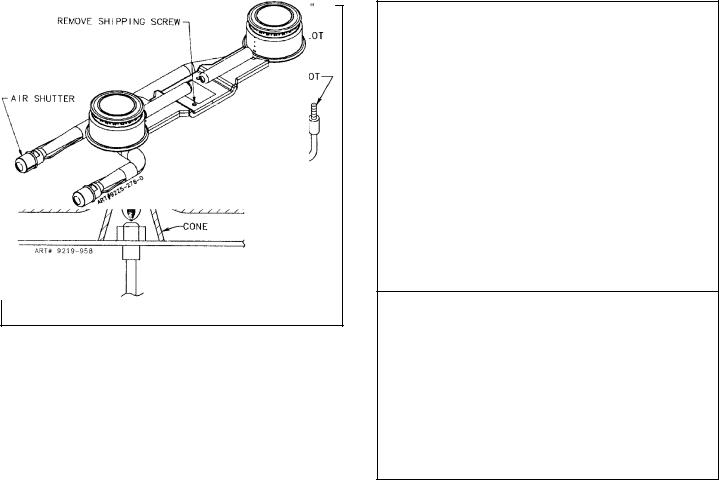
RANGE ADJUSTMENTS
Top Section - Gas Top Pilot Adjustment
(See figure 6)
Purge all air from supply system by turning on one top burner valve. Then turn off valve and adjust top pilot flame using adjusting screw “A” (figure 6) so that flame is even with top of flash tube. To light the burner, push and turn top burner knob to the lite position. NOTE: Some models have ONLY one pilot adjustment at the manifold pipe.
Top Burner Adjustment
All Top Burner Valves: The approximate height of the flame at the high or full-on position is shown below.
Adjust burner air shutter to the widest opening that will not cause the flame to lift or blow off the burner when cold. NOTE: Correctly adjusted sealed burners, can have flames that will lift or blow off without a pot over the burner. These should be adjusted with a pot in place.
FIGURE 6
Top Section - Electric Ignition
To operate, push and turn top burner knob to the LITE position. The top burner will light. To turn OFF spark after the top burner has ignited turn knob to HI setting.
3/4 FLAME
CONVENTIONAL BURNERS
SEALED BURNERS
FIGURE 7
-7-
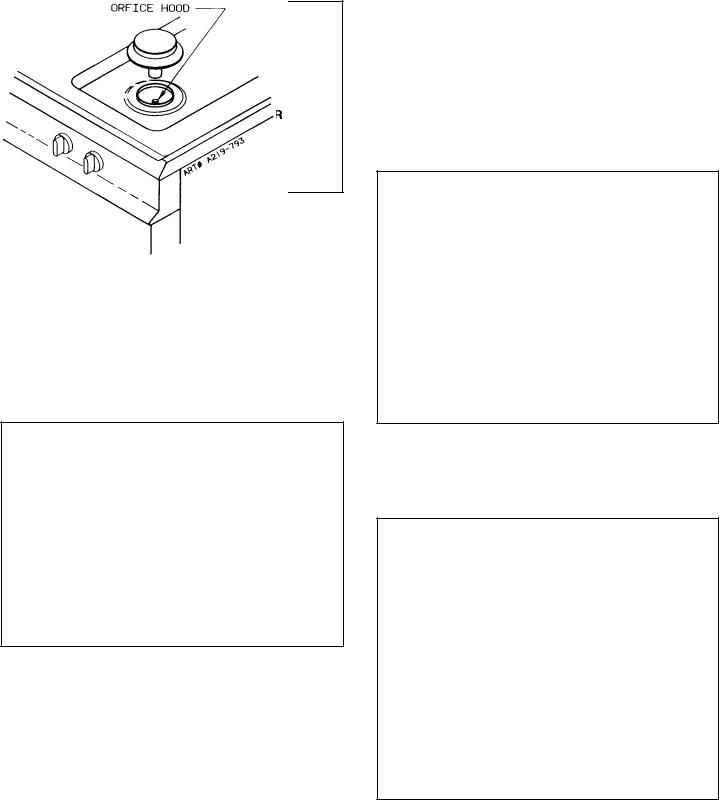
Air Shutter - Oven Burner
a.The approximate length of the flame of oven burner is a 1/2 inch distinct inner blue flame, figure 8.
FIGURE 8
b.Oven burner flame can be checked as follows:
1.Yellow flame on burner - open burner air shutter to the widest opening that will not cause the flame to lift or blow off the burner when cold. (See #2 on figure 9).
2.Distinct blue flame but lifting - close burner air shutter to the point where it will not cause the flame to lift or blow off the burner when cold. (See #2 on figure 9).
c.The oven burner air shutter adjustment is the same on ranges with a gas pilot or electric ignition.
FIGURE 9
High Altitude Notice
The specified gas burner ratings typically apply to elevations up to 2000 feet. For higher altitudes, the rates may need to be reduced to achieve satisfactory operation. A local certified gas servicer will be able to advise if a reduction is necessary.
Removing Sealed Burner For Adjustment Or
Service:
Mark ignitor location relative to main top with pencil. This mark on the main top is used as a reference point when replacing the burner assembly to insure that the burner is tightened to its original position.
Place burner wrench (part no. 8312D075-60, available from your dealer or authorized service agency) over surface burner assembly with ignitor positioned inside gap in wrench ring (figure 10). This prevents ignitor from being crushed when wrench tightens on burner assembly. Rotate burner assembly approximately one-eighth turn counter-clockwise and lift from main top (figure 11).
FIGURE 10
To Reassemble: Replace burner assembly in main top and rotate approximately one-eighth turn clockwise using burner wrench until burner locks into position with ignitor aligned with reference mark on main top.
FIGURE 11
-8-

GAS CONVERSION
General
All ranges are equipped with fixed orifices and with a convertible appliance pressure regulator. The unit model number plate states which gas it was adjusted for at the factory. To convert the unit to either Natural gas or LP gas will require the replacement of orifice hoods, adjustment of the air shutters on the burners and adjustment of the appliance pressure regulator converter cap.
SEE INSTRUCTIONS FOR GAS CONVERSION LOCATED ON THE BACK OF THE RANGE.
Inlet pressure to the appliance pressure regulator should be as follows for both operation and checking of appliance pressure regulator setting:
INLET PRESSURE IN |
NATURAL |
LP |
INCHES OF WATER COLUMN |
GAS |
GAS |
Minimum |
5 |
11 |
Maximum |
14 |
14 |
HOW TO REMOVE RANGE FOR SERVICING
Follow these procedures to remove appliance for servicing:
1.Shut off gas supply to appliance.
2.Disconnect electrical supply to appliance, if equipped.
3.Disconnect gas supply tubing to appliance.
4.Slide range forward to disengage range from the anti-tip bracket. (See page 4).
5.Reverse procedure to reinstall. If gas line has been disconnected, check for gas leaks after reconnection.
NOTE: A qualified servicer should disconnect and reconnect the gas supply.
The servicer MUST follow installation instructions provided with the gas appliance connector and the warning label attached to the connector.
6.To prevent range from accidentally tipping, range must be secured to the floor by sliding rear leveling leg into the anti-tip bracket.
SERVICE-PARTS INFORMATION
When your range requires service or replacement parts, contact your dealer or authorized service agency. Please give the complete model and serial numbers of the range which is located on the range model number plate.
-9-
